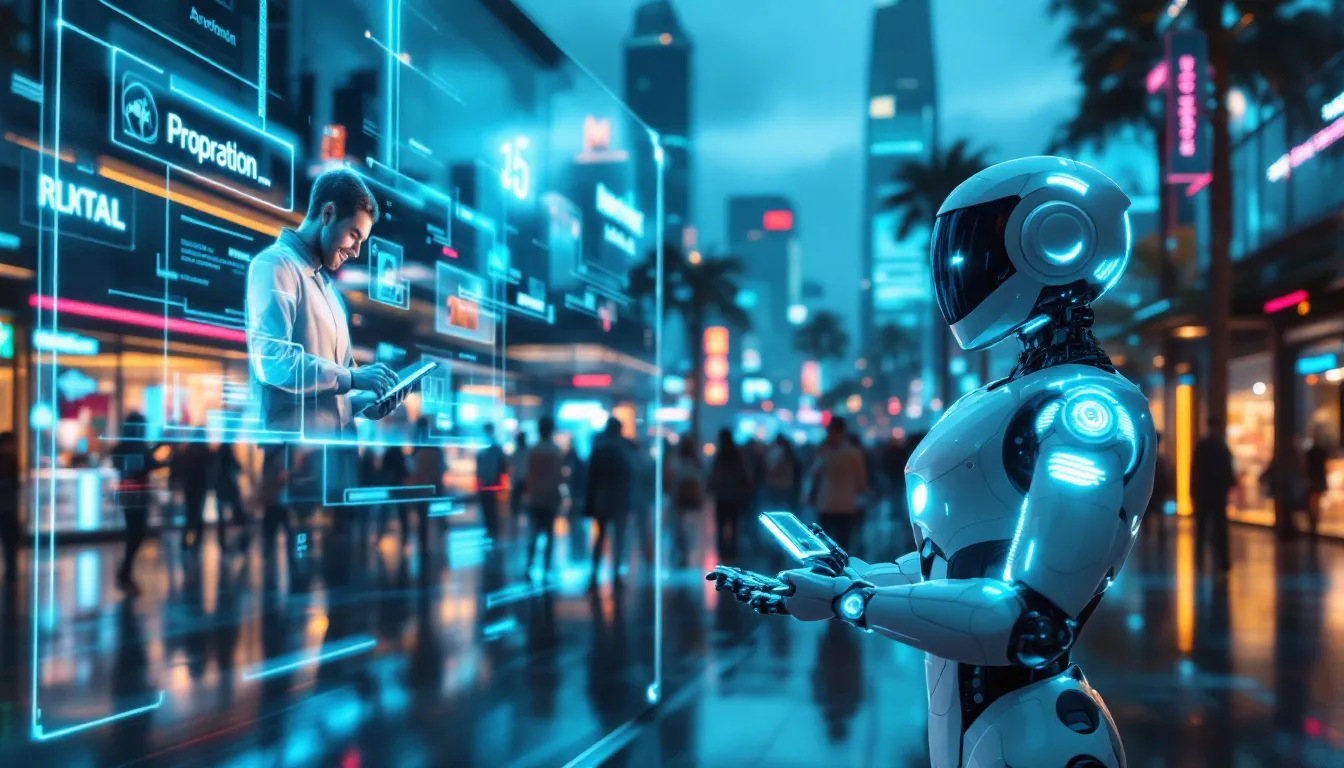As a technology enthusiast and avid shopper, I am thrilled to explore how generative AI for retail is reshaping the shopping experience. This cutting-edge technology is transforming how retailers interact with customers, offering more personalized and efficient solutions than ever before.
From virtual try-ons to intelligent inventory management, generative AI enhances convenience and empowers businesses to meet consumer needs better. In this article, you’ll discover how retailers use this technology to personalize shopping, manage inventory better, and increase sales.
This article follows up on my other article about AI trends.
Key Takeaways
- Generative AI is revolutionizing retail by enhancing customer experiences, improving operational efficiencies, and enabling highly personalized shopping journeys.
- Retailers like Walmart and Amazon leverage generative AI to predict demand, streamline inventory management, and offer tailored recommendations, driving customer satisfaction and loyalty.
- The future of retail will be shaped by generative AI technologies, including AI-powered visual search and personalized marketing, presenting vast opportunities for growth and innovation.
The Role of Generative AI in Retail

Generative AI is dramatically reshaping the retail industry, improving customer connections and operational efficiencies. This revolutionary technology can transform retail by delivering greater value to customers, workers, and businesses. Imagine AI seamlessly integrating with the entire retail value chain, creating new content, predicting market trends, and enhancing customer engagement.
Retailers adopting generative AI tools are at the forefront of a new era, leveraging customer data across multiple channels and regions. Generative AI offers capabilities that older technologies could never match, from maximizing sales to predicting new revenue sources. This technology helps retail leaders drive business growth and achieve maximum ROIs.
Understanding Generative AI
Generative AI refers to models that generate new data samples similar to the data they were trained on. These advanced models can create infinite, contextualized content across text, images, videos, and code. Its magic lies in producing summaries, interpreting large datasets, and designing new products based on market trends and customer interactions.
Studies show that humans often cannot distinguish AI-generated content from human-created content. In retail, generative AI can be used for product design, enhancing product image creation, and generating multiple design variations.
Utilizing datasets as extensive as the entire internet, generative AI models bring unprecedented personalization and innovation to retail.
Key Technologies Behind Generative AI
Generative AI is powered by sophisticated algorithms, including large language models and machine learning techniques, which analyze and generate content. These technologies enable AI-powered chatbots and virtual assistants to interrelate with clients in a human-like manner, delivering personalized shopping experiences and improving overall engagement.
Enhancing Customer Experiences with Generative AI

Generative AI is a game-changer that enhances customer experiences in the retail industry. With 60% of retailers planning to adopt AI technologies for in-store and online experiences, the future of shopping is set to become more personalized and engaging. By analyzing customer preferences and browsing behavior, generative AI can create highly personalized shopping experiences that delight customers and foster loyalty.
By automating numerous customer interactions and tasks, this technology streamlines operations and improves efficiency. AI-driven visual search technology allows consumers to find products by simply uploading images, making the shopping experience more intuitive and enjoyable.
Personalized Shopping Experiences
Generative AI enables tailored recommendations and suggestions based on individual customer preferences. For instance, Amazon uses generative AI to enhance its recommendation engine, predicting future customer preferences and significantly improving satisfaction. By analyzing search history, demographic data, and buying behaviors, it provides intelligent suggestions that make the shopping journey smoother.
Generative AI can also generate personalized shopping lists tailored to dietary restrictions and preferences and create personalized product images by synthesizing text descriptions with historical image data. This level of personalization increases customer satisfaction, boosts conversion rates, and drives sales.
Virtual Shopping Assistants
Virtual shopping assistants powered by generative AI are transforming customer interactions by providing complex, human-like conversations via chatbots. These assistants handle customer queries, provide tailored product suggestions, and even recognize customer emotions or sarcasm, making interactions more engaging and effective. For example, eBay’s ShopBot acts as a personal shopping assistant, offering tailored suggestions based on user understanding and interactions through text, voice, or photos.
These virtual assistants can access valuable information such as inventory levels, store hours, and product research using real-time data. This reduces staffing needs and enhances the customer experience by delivering timely and suitable information to store associates.
With 25% of shoppers expressing interest in using a generative AI shopping assistant, the adoption of this technology is set to grow.
Optimizing Retail Operations

Generative AI enhances customer experiences and optimizes retail operations. It reduces time spent on customer service tasks, increases employee productivity, and lowers procurement costs, improving operational efficiency. Key technologies driving this transformation include AI-powered virtual assistants, tailored product recommendations, and supply chain optimization.
Generative AI plays a crucial role in employee onboarding and training, generating summaries of product features and creating interactive training scenarios. Focusing on reskilling and continuous learning among employees is essential as generative AI reshapes various operational aspects of retail, including product design, demand forecasting, and inventory management.
Inventory Management & Supply Chain Optimization
Generative AI enhances inventory management and supply chain optimization by accurately predicting market demand to improve inventory management. Forecasting demand helps retailers reduce overstock and stockouts, minimizing financial losses from inventory shortages or excess stock. This precise forecasting guides decisions about product stocking and service enhancements.
Generative AI also streamlines logistics in supply chain management, improving product accessibility and ensuring retailers meet customer demands more efficiently. For instance, Walmart uses AI chatbots to negotiate vendor contracts effectively, achieving a high closure rate and cost savings.
These capabilities highlight generative AI’s substantial financial benefits to inventory management and supply chain operations.
Automated Content Generation
Generative AI revolutionizes content creation by automating marketing content production, including visuals and audio. Retailers can quickly produce a wide range of content, significantly lowering production time and costs. For example, Shopify Magic, an AI-powered tool, automates text generation for e-commerce content, such as product descriptions and email subject lines.
However, retailers must review and validate AI-generated content to ensure accuracy and compliance with brand standards. Advancements in AI’s contextual abilities allow retailers to standardize product descriptions across various sellers, enhancing consistency and improving the overall shopping experience.
Boosting Customer Loyalty and Engagement

Generative AI significantly boosts customer loyalty and engagement. With 74.7% of consumers inclined to make repeat purchases from brands that provide personalized experiences, tailored interactions are crucial. Generative AI enables hyper-personalized customer outreach, enhancing engagement through relevant promotions and recommendations.
Around 50% of retail customers recognize the potential of generative AI to enhance their shopping experience, valuing integrated features like automated review summaries more than standalone applications. Retail leaders prioritize generative AI in marketing strategies to advance customer loyalty and drive business growth.
Personalized Marketing Campaigns
Personalized marketing campaigns created by generative AI are highly effective in reducing brand fatigue and increasing customer loyalty. By analyzing customer data such as past purchasing behavior and preferences, generative AI creates content that resonates with individual customers. This technology predicts the promotional content that will appeal to each customer, making marketing campaigns more effective.
Generative AI allows for infinite A/B tests to identify the most effective content, continuously improving marketing strategies. Shoppers are gradually willing to share personal data to receive better recommendations, making generative AI invaluable for modern retail marketing.
Synthesizing Customer Feedback
Generative AI excels in synthesizing customer feedback from diverse sources, such as reviews and social media, to inform product changes and innovations. By summarizing customer comments, retailers quickly gain insights into consumer preferences and pain points, enabling data-driven decisions about product stocking, store placement, and service enhancements.
Customers appreciate AI-generated review summaries for saving time, aiding decision-making, and enhancing their shopping experience. This feedback synthesis improves customer satisfaction and helps retailers stay ahead of consumer behavior trends, maintaining a competitive edge.
Real-World Applications of Generative AI in Retail

Generative AI significantly changes customer experiences and enhances backend operations in the retail industry. Retailers have quickly taken advantage of its myriad attributes, reshaping business conduct and enhancing interactions. This technology revolutionizes product design, provides advanced capabilities, and simplifies shopping experiences, as seen with companies like Instacart.
Generative AI leads to enhanced shopper interactions and streamlined processes for retailers, making it invaluable in the modern retail landscape.
Here’s how two retail giants, Walmart and Amazon, use generative AI to remain ahead of the curve.
Case Study: Walmart
Walmart employs generative AI to enhance its supply chain, helping predict demand fluctuations and adjust inventory levels. Walmart has improved product availability, reduced waste, and enhanced operational efficiency through its AI-powered system. These advancements benefit the company and improve the customer experience by ensuring products are always available when needed.
In addition to supply chain optimization, Walmart uses generative AI to create product descriptions, summarize documents, generate content, and provide cross-sell recommendations. These capabilities streamline operations and enhance the customer shopping experience, showcasing the transformative power of generative AI in retail.
Case Study: Amazon
Amazon has integrated advanced generative AI algorithms into its retail platform to refine shopping experiences. By analyzing past customer behaviors and preferences, Amazon uses generative AI to offer personalized product recommendations, significantly enhancing customer satisfaction. This approach improves the shopping experience and drives higher sales and loyalty.
Amazon has deployed AI-driven chatbots and virtual assistants that provide automated customer service, ensuring real-time assistance. The implementation of generative AI allows Amazon to streamline shopping processes and maintain a competitive edge in the evolving retail landscape.
Future Prospects of Generative AI in Retail
Generative AI is poised to revolutionize functions across the entire retail value chain. From greater personalization in customer interactions to more efficient supply chains and innovative shopping experiences, the future of retail looks promising, with generative AI at its core. Retail leaders anticipate these changes and prepare to integrate more advanced AI tools and models into their operations.
The transformative potential of generative AI extends beyond current applications. Emerging trends like AI-powered visual search, augmented reality, and more sophisticated virtual assistants are set to redefine how consumers interrelate with products and services.
However, with these advancements come challenges that retailers must navigate to ensure successful generative AI implementation.
Emerging Trends
Generative AI has the potential to become a key element of e-commerce experiences. Technologies such as AI-powered visual search and augmented reality are changing how customers engage with products. Imagine using Google Chrome’s latest update, which includes an advanced version of Google Lens for visual search, to find exactly what you’re looking for with just an image. These technologies enhance customer engagement and supply a competitive edge to retailers who adopt them early.
As consumer choices continue to evolve, the ability of generative AI to adapt and offer personalized experiences will become increasingly vital. Retail leaders must stay ahead of market trends and always innovate to meet the changing demands of their customers.
The future of retail will be defined by those who can seamlessly integrate these emerging technologies into their business models.
Challenges and Considerations
While the potential of generative AI is immense, retailers face several challenges when implementing this technology. One of the primary concerns is the risk of non-factual responses and the high investment required for validation. Additionally, developing ethical policies and teaching AI literacy is critical to mitigate the risks linked to generative AI. The presence of inherent biases in data and processes can undermine consumer trust, making it essential for retailers to prioritize ethical AI practices.
Data privacy is another critical concern as customers become increasingly aware of how their information is utilized. Retailers must focus on developing robust data protection measures to ensure consumer confidence and maintain a competitive edge. Addressing these challenges head-on will be key to opening the full potential of generative AI in retail.
Concluding Remarks
Generative AI is undeniably revolutionizing the retail industry, offering a myriad of benefits, from personalized shopping experiences to optimized operations. As we’ve explored, the technology enhances customer engagement, streamlines supply chain management, and automates content generation, all while providing valuable insights that drive business growth.
Retail leaders like Walmart and Amazon are already reaping the benefits, showcasing the transformative power of generative AI.
The future of retail is bright with generative AI, but it requires careful consideration of ethical practices, data privacy, and continuous innovation. By embracing these technologies and managing the associated challenges, retailers can unlock new levels of efficiency and customer satisfaction.
As we move forward, integrating generative AI will undoubtedly shape the future of shopping, creating a more personalized, efficient, and engaging retail landscape.
Be sure to explore my other articles on Artificial Intelligence and its applications.
Frequently Asked Questions
1. What is generative AI, and how does it apply to retail?
Generative AI is an exciting technology that creates new data similar to what it’s trained on, and it can greatly enhance the retail experience by personalizing shopping, optimizing supply chains, and automating content. Welcoming this revolution can lead to a more engaging and efficient customer shopping journey.
2. How does generative AI enhance customer experiences?
Generative AI greatly enhances customer experiences by personalizing shopping journeys based on individual preferences and behavior. Tools like virtual assistants and customized product recommendations ensure that every interaction feels relevant and engaging.
3. What are the benefits of generative AI in inventory management?
Generative AI significantly improves inventory management by enhancing demand forecasting, which helps minimize overstock and stockouts. This not only ensures better product availability and reduces waste but also leads to substantial financial gains for retailers.
4. How do retailers use generative AI for marketing?
Retailers effectively use generative AI to craft personalized marketing campaigns that resonate with their customers, enhancing brand loyalty and reducing fatigue. They successfully engage their audience with tailored content by leveraging customer data and predictive analytics.
5. What challenges do retailers face when implementing generative AI?
Retailers encounter challenges like the risk of non-factual responses and high validation costs when adopting generative AI. By proactively addressing data privacy and ethical policies, they can turn these barriers into opportunities for growth and innovation.



